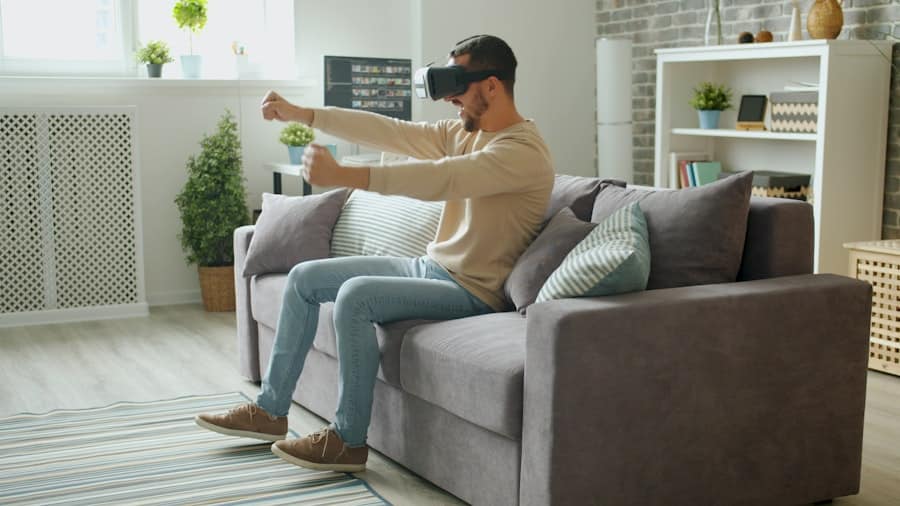Virtual reality (VR) is a technology that immerses users in a computer-generated environment, allowing them to interact with 3D worlds in a seemingly real way. This immersive experience is achieved through the use of VR headsets, which provide stereoscopic displays and track the user’s head movements, creating a sense of presence within the virtual space. The origins of VR can be traced back to the 1960s, but it has gained significant traction in recent years due to advancements in hardware and software, making it more accessible to developers and consumers alike.
The applications of virtual reality are vast and varied, spanning industries such as gaming, education, healthcare, and real estate. In gaming, VR offers players an unparalleled level of engagement, allowing them to step into their favorite games and interact with characters and environments in ways that traditional gaming cannot replicate. In education, VR can transport students to historical sites or simulate complex scientific phenomena, enhancing learning through experiential engagement.
Healthcare professionals utilize VR for training simulations, enabling them to practice procedures in a risk-free environment. The versatility of VR technology continues to expand as developers explore new ways to leverage its immersive capabilities.
Key Takeaways
- Virtual reality (VR) is a computer-generated simulation of an environment that can be interacted with in a seemingly real or physical way.
- When choosing the right VR platform, consider factors such as hardware compatibility, software support, and user base.
- Planning your VR experience involves defining the goals, target audience, and user experience, as well as creating a storyboard or script.
- Creating 3D models and assets for VR requires specialized software and skills in 3D modeling, texturing, and animation.
- Developing interactive elements in VR involves programming and integrating user interactions, such as gestures, voice commands, and haptic feedback.
Choosing the Right VR Platform
Selecting the appropriate VR platform is crucial for the success of any virtual reality project. The choice often depends on the target audience, the type of experience being created, and the available resources. Major platforms include Oculus Rift, HTC Vive, PlayStation VR, and mobile-based solutions like Oculus Quest and Google Cardboard.
Each platform has its unique strengths and limitations, influencing factors such as graphics quality, interactivity, and accessibility. For instance, Oculus Rift and HTC Vive are known for their high-fidelity graphics and extensive tracking capabilities, making them ideal for complex gaming experiences or detailed simulations. On the other hand, mobile VR platforms like Oculus Quest offer a more accessible entry point for users who may not have high-end gaming PCs.
These platforms allow for untethered experiences, enabling users to move freely without being constrained by cables. When choosing a platform, developers must also consider the development tools available for each system, as some platforms offer more robust support for creating interactive content than others.
Planning Your VR Experience

Effective planning is essential for creating a successful VR experience. This phase involves defining the goals of the project, understanding the target audience, and outlining the user journey within the virtual environment. Developers should start by asking critical questions: What is the primary purpose of the experience?
Is it meant to entertain, educate, or inform?
This visual representation helps identify key interactions and transitions within the VR environment. For example, if developing an educational VR experience about marine biology, the storyboard might include scenes depicting underwater ecosystems, interactive quizzes about marine life, and opportunities for users to explore different habitats. By planning these elements in advance, developers can create a cohesive narrative that enhances user engagement and learning.
Creating 3D Models and Assets
The creation of 3D models and assets is a fundamental aspect of developing a virtual reality experience. These models serve as the building blocks of the virtual environment, providing users with visual elements to interact with. Depending on the complexity of the project, developers may choose to create their models from scratch using software like Blender or Autodesk Maya or utilize pre-existing assets from online libraries such as TurboSquid or Sketchfab.
When designing 3D models for VR, it is essential to consider factors such as polygon count and texture resolution. High-quality models with intricate details can enhance realism but may also impact performance if not optimized correctly. Developers should aim for a balance between visual fidelity and performance efficiency.
For instance, using normal maps can give the illusion of detail on lower-polygon models without significantly increasing rendering costs. Additionally, creating modular assets allows for greater flexibility in building environments while maintaining consistency across different scenes.
Developing Interactive Elements
Interactivity is one of the defining features of virtual reality experiences. Users expect to engage with their surroundings in meaningful ways, whether through simple actions like picking up objects or more complex interactions like solving puzzles or navigating through challenges. To achieve this level of interactivity, developers must implement various input methods that allow users to manipulate objects within the virtual space.
Common input methods include hand tracking, motion controllers, and gaze-based interactions. For example, using motion controllers allows users to physically reach out and grab objects, enhancing immersion. Developers can also incorporate haptic feedback to provide tactile sensations when users interact with virtual elements, further enriching the experience.
Additionally, scripting interactions using game engines like Unity or Unreal Engine enables developers to create dynamic responses based on user actions. For instance, if a user picks up a virtual tool in a construction simulation, they might trigger a series of animations that demonstrate how to use it effectively.
Testing and Iterating

Testing is a critical phase in the development of any VR experience. It involves gathering feedback from users to identify areas for improvement and ensure that the experience is intuitive and enjoyable. Developers should conduct playtesting sessions with individuals who represent their target audience to gain insights into how users interact with the environment and whether they encounter any challenges.
During testing, developers should pay close attention to user behavior and feedback regarding navigation, interactivity, and overall enjoyment. Observing users as they engage with the experience can reveal unexpected issues or areas where enhancements are needed. For example, if users struggle to locate specific interactive elements or become disoriented within the environment, developers may need to adjust navigation cues or simplify interactions.
Iteration based on user feedback is essential for refining the experience and ensuring that it meets user expectations.
Optimizing for Performance
Performance optimization is vital in virtual reality development due to the demanding nature of rendering immersive environments in real-time. A smooth frame rate is crucial for maintaining immersion; any lag or stuttering can lead to discomfort or motion sickness for users. Developers must employ various techniques to optimize their VR experiences while preserving visual quality.
One effective strategy is level of detail (LOD) management, which involves creating multiple versions of 3D models with varying levels of detail based on their distance from the user. Objects closer to the user can be rendered with high detail, while those further away can use lower-resolution models without sacrificing visual fidelity. Additionally, developers should consider implementing occlusion culling techniques that prevent rendering objects not currently visible to the user.
This approach reduces the overall rendering load on the system while maintaining an engaging visual experience. Another important aspect of optimization is efficient use of textures and materials. Developers can utilize texture atlases to combine multiple textures into a single image file, reducing draw calls during rendering.
Furthermore, compressing textures without significant loss of quality can help improve performance while ensuring that visual elements remain appealing.
Publishing and Sharing Your VR Experience
Once development is complete and thorough testing has been conducted, it’s time to publish and share your VR experience with the world. The distribution process varies depending on the chosen platform; for instance, Oculus Store or SteamVR have specific guidelines that developers must follow when submitting their applications. Ensuring compliance with these guidelines is essential for successful publication.
Marketing plays a crucial role in reaching potential users after publication. Developers should create promotional materials such as trailers or screenshots that showcase key features of their VR experience. Engaging with communities on social media platforms or forums dedicated to VR can also help generate interest and attract users who are eager to explore new content.
Additionally, gathering user reviews post-launch can provide valuable feedback for future updates or projects. In conclusion, sharing your VR experience goes beyond mere publication; it involves fostering a community around your work and encouraging user engagement through updates and new content releases. By actively participating in discussions and responding to user feedback, developers can build lasting relationships with their audience while continuously improving their offerings in this rapidly evolving field.
If you’re interested in diving deeper into the world of technology after reading the “Beginner’s Guide to Creating a VR Experience,” you might find the article on Enicomp’s Original Home for Technology News and Reviews particularly insightful. This article provides a broader context on the latest trends and innovations in technology, which can be incredibly beneficial for anyone looking to expand their knowledge and stay updated on the cutting-edge developments in the tech world.
FAQs
What is VR?
VR stands for virtual reality, which is a computer-generated simulation of an environment that can be interacted with in a seemingly real or physical way by a person using special electronic equipment, such as a helmet with a screen inside or gloves fitted with sensors.
What is a VR experience?
A VR experience is a simulated environment that can be similar to or completely different from the real world. It can be designed for entertainment, educational, or training purposes, and it allows users to interact with and experience the environment as if they were actually there.
What are the steps to creating a VR experience?
The steps to creating a VR experience include defining the concept and goals, designing the environment and interactions, developing the software and content, testing and refining the experience, and finally, deploying it for users to experience.
What equipment is needed to create a VR experience?
To create a VR experience, you will need a computer with powerful hardware, VR development software such as Unity or Unreal Engine, VR headsets like Oculus Rift or HTC Vive, motion controllers, and possibly additional peripherals like haptic feedback devices or motion capture systems.
What skills are required to create a VR experience?
Creating a VR experience requires a combination of skills including 3D modeling and animation, programming (C#, C++, or other languages), game design, user experience design, and possibly audio engineering and storytelling. Collaboration with a team of specialists is often necessary to create a high-quality VR experience.
What are some best practices for creating a VR experience?
Some best practices for creating a VR experience include optimizing performance for smooth and immersive interactions, designing intuitive and comfortable user interfaces, providing clear instructions and feedback, testing the experience with real users, and continuously iterating based on feedback and insights.

